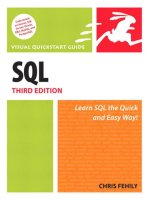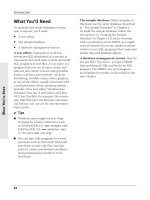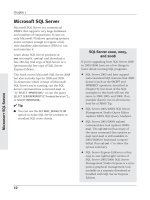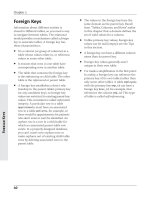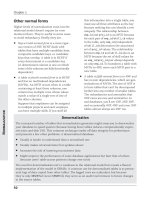SQL VISUAL QUICKSTART GUIDE- P13 ppsx
Bạn đang xem bản rút gọn của tài liệu. Xem và tải ngay bản đầy đủ của tài liệu tại đây (186.21 KB, 10 trang )
■
You can sort by the results of expres-
sions; Chapter 5 describes how to create
expressions by using functions and oper-
ators (Listing 4.17 and Figure 4.17).
■
You can intermingle column names,
relative column positions, and expres-
sions in
ORDER BY
.
■
You should create indexes for columns
that you sort frequently (see Chapter 12).
■
The sequence in which unordered rows
appear actually is based on the physical
order of rows in the DBMS table. You
shouldn’t rely on physical order because
it changes often, such as when rows are
added, updated, or deleted or an index
is created.
■
Sorting by relative column position is
useful in
UNION
queries; see “Combining
Rows with
UNION
” in Chapter 9.
■
DBMSs restrict the columns that
can appear in an
ORDER BY
clause,
depending on data type. For example, in
Microsoft SQL Server, you can’t sort by
ntext
,
text
, and
image
columns; and in
Oracle, you can’t sort by
blob
,
clob
,
nclob
, and
bfile
columns. Search your
DBMS documentation for SELECT or
ORDER BY.
In Microsoft Access you can’t use an
expression’s column alias in
ORDER BY
.
To run Listing 4.17, either retype the
expression in the
ORDER BY
clause:
ORDER BY price * sales DESC
or use the relative column position:
ORDER BY 4 DESC
100
Chapter 4
Sorting Rows with ORDER BY
Listing 4.17 This query sorts by an expression. See
Figure 4.17 for the result. I’ve created a column alias
for the expression because it would be cumbersome
to repeat the expression in the
ORDER BY
clause and
because it creates a more meaningful column label in
the result.
SELECT title_id,
price,
sales,
price * sales AS "Revenue"
FROM titles
ORDER BY "Revenue" DESC;
Listing
title_id price sales Revenue
T07 23.95 1500200 35929790.00
T05 6.95 201440 1400008.00
T12 12.99 100001 1299012.99
T03 39.95 25667 1025396.65
T11 7.99 94123 752042.77
T13 29.99 10467 313905.33
T06 19.95 11320 225834.00
T02 19.95 9566 190841.70
T04 12.99 13001 168882.99
T09 13.95 5000 69750.00
T08 10.00 4095 40950.00
T01 21.99 566 12446.34
T10 NULL NULL NULL
Figure 4.17 Result of Listing 4.17. This result lists
titles by descending revenue (the product of price
and sales).
Filtering Rows with WHERE
The result of each
SELECT
statement so far
has included every row in the table (for the
specified columns). You can use the
WHERE
clause to filter unwanted rows from the
result. This filtering capability gives the
SELECT
statement its real power. In a
WHERE
clause, you specify a search condition that
has one or more conditions that need to be
satisfied by the rows of a table. A condition,
or predicate, is a logical expression that
evaluates to true, false, or unknown. Rows
for which the condition is true are included
in the result; rows for which the condition
is false or unknown are excluded. (An
unknown result, which arises from nulls, is
described in the next section.) SQL provides
operators that express different types of con-
ditions (Table 4.1). Operators are symbols
or keywords that specify actions to perform
on values or other elements.
SQL’s comparison operators compare two
values and evaluate to true, false, or unknown
(Table 4.2). The data type determines how
values are compared:
◆
Character strings are compared lexico-
graphically.
<
means precedes, and
>
means follows. See “Data Types” in
Chapter 3 and “Sorting Rows with
ORDER
BY
” earlier in this chapter.
◆
Numbers are compared arithmetically.
<
means smaller, and
>
means larger.
◆
Datetimes are compared chronologically.
<
means earlier, and
>
means later.
Datetimes must have the same fields
(year, month, day, hour, and so on) to be
compared meaningfully.
Compare only identical or similar data
types. If you try to compare values that have
different data types, your DBMS might:
◆
Return an error
or
◆
Compare the values unequally and
return a result with no rows
or
◆
Attempt to convert the values to a com-
mon type and compare them if successful
or return an error if unsuccessful
101
Retrieving Data from a Table
Filtering Rows with WHERE
Table 4.1
Types of Conditions
Condition SQL Operators
Comparison
=
,
<>
,
<
,
<=
,
>
,
>=
Pattern matching
LIKE
Range filtering
BETWEEN
List filtering
IN
Null testing
IS NULL
Table 4.2
Comparison Operators
Operator Description
=
Equal to
<>
Not equal to
<
Less than
<=
Less than or equal to
>
Greater than
>=
Greater than or equal to
To filter rows by making a comparison:
◆
Type:
SELECT columns
FROM table
WHERE test_column op value;
columns is one or more comma-separated
column names, and table is the name of
the table that contains columns.
In the search condition, test_column
is the name of a column in table.
(test_column doesn’t have to be listed
in columns.) op is one of the comparison
operators listed in Table 4.2, and value
is a value that’s compared with the value
in test_column (Listings 4.18 through
4.20, Figures 4.18 through 4.20).
✔ Tips
■
Place the
WHERE
clause before the
ORDER
BY
clause in a
SELECT
statement in which
both appear.
■
A null represents the unknown and
won’t match anything, not even another
null. Rows in which nulls are involved in
comparisons won’t be in the result. To
compare nulls, use
WHERE test_column
IS NULL
(
WHERE test_column = NULL
is
incorrect); see “Testing for Nulls with
IS NULL
” later in this chapter. See also
“Nulls” in Chapter 3.
102
Chapter 4
Filtering Rows with WHERE
Listing 4.18 List the authors whose last name is not
Hull. See Figure 4.18 for the result.
SELECT au_id, au_fname, au_lname
FROM authors
WHERE au_lname <> 'Hull';
Listing
au_id au_fname au_lname
A01 Sarah Buchman
A02 Wendy Heydemark
A05 Christian Kells
A06 Kellsey
A07 Paddy O'Furniture
Figure 4.18 Result of Listing 4.18.
Listing 4.19 List the titles for which there is no signed
contract. See Figure 4.19 for the result.
SELECT title_name, contract
FROM titles
WHERE contract = 0;
Listing
title_name contract
Not Without My Faberge Egg 0
Figure 4.19 Result of Listing 4.19.
■
The right and left sides of the comparison
can be more complex than I described.
The general form of a comparison is:
expr1 op expr2
expr1 and expr2 are expressions. An
expression is any valid combination of
column names, literals, functions, and
operators that resolves to a single value
(per row). Chapter 5 covers expressions
in more detail (Listing 4.21 and
Figure 4.21).
■
For speed, fold your constants into a
minimal number of expressions. For
example, change
WHERE col1 + 2 <= 10
to
WHERE col1 <= 8
The best practice is to put only simple
column references to the left of the
=
and
more-complex expressions to the right.
■
In general, the fastest comparison is for
equality (
=)
, following by the inequalities
(
<
,
<=
,
>
,
>=
). The slowest is not-equal
(
<>
). If possible, express your conditions
by using faster comparisons.
■
You can’t use an aggregate function such
as
SUM()
or
COUNT()
in a
WHERE
clause; see
Chapter 6.
continues on next page
103
Retrieving Data from a Table
Filtering Rows with WHERE
Listing 4.20 List the titles published in 2001 and later.
See Figure 4.20 for the result.
SELECT title_name, pubdate
FROM titles
WHERE pubdate >= DATE '2001-01-01';
Listing
title_name pubdate
Exchange of Platitudes 2001-01-01
Just Wait Until After School 2001-06-01
Kiss My Boo-Boo 2002-05-31
Figure 4.20 Result of Listing 4.20.
Listing 4.21 List the titles that generated more than
$1 million in revenue. This search condition uses an
arithmetic expression. See Figure 4.21 for the result.
SELECT title_name,
price * sales AS "Revenue"
FROM titles
WHERE price * sales > 1000000;
Listing
title_name Revenue
Ask Your System Administrator 1025396.65
Exchange of Platitudes 1400008.00
I Blame My Mother 35929790.00
Spontaneous, Not Annoying 1299012.99
Figure 4.21 Result of Listing 4.21.
■
An operation that selects certain rows
from a table is called a restriction.
■
Your DBMS’s collation determines
whether string comparisons are
case insensitive (‘A’ = ‘a’) or case sensitive
(‘A’ & ‘a’). Microsoft Access, Microsoft
SQL Server, DB2, and MySQL perform
case-insensitive comparisons by default.
Oracle and PostgreSQL perform case-
sensitive comparisons by default. In
general, case-sensitive comparisons are
slightly faster than case-insensitive ones.
See also “Changing String Case with
UPPER()
and
LOWER()
” in Chapter 5.
Case sensitivity can vary by context.
MySQL comparisons are case insensitive
in
WHERE
comparisons but are case sensi-
tive in string-related functions, for
example.
In Microsoft Access date literals, omit
the
DATE
keyword and surround the literal
with # characters instead of quotes. To
run Listing 4.20, change the date in the
WHERE
clause to
#2001-01-01#
.
In Microsoft SQL Server and DB2 date
literals, omit the
DATE
keyword. To run
Listing 4.20, change the date in the
WHERE
clause to
‘2001-01-01’
.
In older PostgreSQL versions, to com-
pare a value in a
NUMERIC
or
DECIMAL
column with a real (floating-point) num-
ber, convert the real number to
NUMERIC
or
DECIMAL
explicitly. See “Converting
Data Types with
CAST()
” in Chapter 5.
Some DBMSs support the comparison
operator
!=
as a synonym for
<>
(not
equal). You should use
<>
to keep your
code portable.
104
Chapter 4
Filtering Rows with WHERE
Column Aliases and WHERE
If you alias a column in a
SELECT
clause
(see “Creating Column Aliases with
AS
”
earlier in this chapter), you can’t refer-
ence it in the
WHERE
clause. The following
query fails because the
WHERE
clause is
evaluated before the
SELECT
clause, so the
alias
copies_sold
doesn’t yet exist when
the
WHERE
clause is evaluated:
Wrong
SELECT sales AS copies_sold
FROM titles
WHERE copies_sold > 100000;
Instead, use a subquery (Chapter 8) in the
FROM
clause, which is evaluated before the
WHERE
clause:
Correct
SELECT *
FROM (SELECT sales AS copies_sold
FROM titles) ta
WHERE copies_sold > 100000;
This solution works not only for columns
aliases but also for aggregate functions,
scalar subqueries, and windowing func-
tions referenced in
WHERE
clauses. Note
that in the latter query, the subquery is
aliased
ta
(a table alias). All DBMSs
accept table aliases, but not all require
them. See also “Using Subqueries as
Column Expressions” in Chapter 8.
Combining and Negating
Conditions with AND, OR,
and NOT
You can specify multiple conditions in a
single
WHERE
clause to, say, retrieve rows
based on the values in multiple columns.
You can use the
AND
and
OR
operators to
combine two or more conditions into a
compound condition.
AND
,
OR
, and a third
operator,
NOT
, are logical operators. Logical
operators, or Boolean operators, are opera-
tors designed to work with truth values: true,
false, and unknown.
If you’ve programmed in other languages (or
studied propositional logic), you’re familiar
with the two-value logic (2VL) system. In
two-value logic, the result of a logical expres-
sion is either true or false. 2VL assumes per-
fect knowledge, in which all propositions are
known to be true or false. Databases model
real data, however, and our knowledge of the
world is imperfect—that’s why we use nulls
to represent unknown values (see “Nulls” in
Chapter 3).
2VL is insufficient to represent knowledge
gaps, so SQL uses three-value logic (3VL).
In three-value logic, the result of a logical
expression is true, false, or unknown. If the
result of a compound condition is false or
unknown, the row is excluded from the result.
(To retrieve rows with nulls, see “Testing for
Nulls with
IS NULL
” later in this chapter.)
105
Retrieving Data from a Table
Combining and Negating Conditions
The AND operator
The
AND
operator’s important characteris-
tics are:
◆
AND
connects two conditions and returns
true only if both conditions are true.
◆
Table 4.3 shows the possible outcomes
when you combine two conditions with
AND
. The table’s left column shows the
truth values of the first condition, the
top row shows the truth values of the
second condition, and each intersection
shows the
AND
outcome. This type of
table is called a truth table.
◆
Any number of conditions can be con-
nected with
AND
s. All the conditions
must be true for the row to be included
in the result.
◆
AND
is commutative (independent of
order):
WHERE condition1 AND condition2
is equivalent to
WHERE condition2 AND
condition1
.
◆
You can enclose one or both of the con-
ditions in parentheses. Some compound
conditions need parentheses to force the
order in which conditions are evaluated.
See Listings 4.22 and 4.23, and Figures
4.22 and 4.23, for some
AND
examples.
106
Chapter 4
Combining and Negating Conditions
Table 4.3
AND True False Unknown
True True False Unknown
False False False False
Unknown Unknown False Unknown
Listing 4.22 List the biographies that sell for less than
$20. See Figure 4.22 for the result.
SELECT title_name, type, price
FROM titles
WHERE type = 'biography' AND price < 20;
Listing
title_name type price
How About Never? biography 19.95
Spontaneous, Not Annoying biography 12.99
Figure 4.22 Result of Listing 4.22.
Listing 4.23 List the authors whose last names begin
with one of the letters H through Z and who don’t live
in California. See Figure 4.23 for the result.
SELECT au_fname, au_lname
FROM authors
WHERE au_lname >= 'H'
AND au_lname <= 'Zz'
AND state <> 'CA';
Listing
au_fname au_lname
Wendy Heydemark
Christian Kells
Paddy O'Furniture
Figure 4.23 Result of Listing 4.23. Remember that the
results of string comparisons depend on the DBMS’s
collating sequence; see “Sorting Rows with
ORDER BY
”
earlier in this chapter.
The OR operator
The
OR
operator’s important characteristics are:
◆
OR
connects two conditions and returns
true if either condition is true or if both
conditions are true.
◆
Table 4.4 shows the
OR
truth table.
◆
Any number of conditions can be con-
nected with
OR
s.
OR
will retrieve rows that
match any condition or all the conditions.
◆
Like
AND
,
OR
is commutative; the order
in which you list the conditions doesn’t
matter.
◆
You can enclose one or both of the con-
ditions in parentheses.
See Listings 4.24 and 4.25, and Figures
4.24 and 4.25, for some
OR
examples.
Listing 4.25 shows the effect of nulls in
conditions. You might expect the result,
Figure 4.25, to display all the rows in the
table
publishers
. But the row for publisher
P03 (located in Germany) is missing because
it contains a null in the column
state
. The
null causes the result of both of the
OR
con-
ditions to be unknown, so the row is exclud-
ed from the result. To test for nulls, see
“Testing for Nulls with
IS NULL
” later in this
chapter.
107
Retrieving Data from a Table
Combining and Negating Conditions
Table 4.4
OR True False Unknown
True True True True
False True False Unknown
Unknown True Unknown Unknown
Listing 4.24 List the authors who live in New York
State, Colorado, or San Francisco. See Figure 4.24 for
the result.
SELECT au_fname, au_lname, city, state
FROM authors
WHERE (state = 'NY')
OR (state = 'CO')
OR (city = 'San Francisco');
Listing
au_fname au_lname city state
Sarah Buchman Bronx NY
Wendy Heydemark Boulder CO
Hallie Hull San Francisco CA
Klee Hull San Francisco CA
Christian Kells New York NY
Figure 4.24 Result of Listing 4.24.
Listing 4.25 List the publishers that are located in
California or are not located in California. This example
is contrived to show the effect of nulls in conditions;
see Figure 4.25 for the result.
SELECT pub_id, pub_name, state, country
FROM publishers
WHERE (state = 'CA')
OR (state <> 'CA');
Listing
pub_id pub_name state country
P01 Abatis Publishers NY USA
P02 Core Dump Books CA USA
P04 Tenterhooks Press CA USA
Figure 4.25 Result of Listing 4.25. Publisher P03 is
missing because its
state
is null.
The NOT operator
The
NOT
operator’s important characteristics are:
◆
Unlike
AND
and
OR
,
NOT
doesn’t connect
two conditions. Instead, it negates
(reverses) a single condition.
◆
Table 4.5 shows the
NOT
truth table.
◆
In comparisons, place
NOT
before the
column name or expression
WHERE NOT state = ‘CA’ Correct
and not before the operator (even though
it sounds better when read):
WHERE state NOT = ‘CA’ Illegal
◆
NOT
acts on one condition. To negate two
or more conditions, repeat the
NOT
for
each condition. To list titles that are not
biographies and are not priced less than
$20, for example, type
SELECT title_id, type, price
FROM titles
WHERE NOT type = ‘biography’
AND NOT price < 20; Correct
and not
SELECT title_id, type, price
FROM titles
WHERE NOT type = ‘biography’
AND price < 20; Wrong
The latter clause is legal but returns the
wrong result. See the Tips in this section
to learn ways to express equivalent
NOT
conditions.
◆
In comparisons, using
NOT
often is a
matter of style. The following two clauses
are equivalent:
WHERE NOT state = ‘CA’
and
WHERE state <> ‘CA’
◆
You can enclose the condition in
parentheses.
108
Chapter 4
Combining and Negating Conditions
Table 4.5
Condition NOT Condition
True False
False True
Unknown Unknown
Listing 4.26 List the authors who don’t live in
California. See Figure 4.26 for the result.
SELECT au_fname, au_lname, state
FROM authors
WHERE NOT (state = 'CA');
Listing
au_fname au_lname state
Sarah Buchman NY
Wendy Heydemark CO
Christian Kells NY
Paddy O'Furniture FL
Figure 4.26 Result of Listing 4.26.
Listing 4.27 List the titles whose price is not less than
$20 and that have sold more than 15,000 copies. See
Figure 4.27 for the result.
SELECT title_name, sales, price
FROM titles
WHERE NOT (price < 20)
AND (sales > 15000);
Listing
title_name sales price
Ask Your System Administrator 25667 39.95
I Blame My Mother 1500200 23.95
Figure 4.27 Result of Listing 4.27.
Using AND, OR, and NOT together
You can combine the three logical operators
in a compound condition. Your DBMS uses
SQL’s precedence rules to determine which
operators to evaluate first. Precedence is
covered in “Determining the Order of
Evaluation” in Chapter 5, but for now you
need know only that when you use multiple
logical operators in a compound condition,
NOT
is evaluated first, then
AND
, and finally
OR
.
You can override this order with parentheses:
Everything in parentheses is evaluated first.
When parenthesized conditions are nested,
the innermost condition is evaluated first.
Under the default precedence rules, the
condition
x AND NOT y OR z
is equivalent
to
(x AND (NOT y)) OR z
. It’s wise to use
parentheses, rather than rely on the default
evaluation order, to make the evaluation
order clear.
If I want to list history and biography titles
priced less than $20, for example, Listing
4.28 won’t work.
AND
is evaluated before
OR
,
so the query is evaluated as follows:
1. Find all the biography titles less than $20.
2.
Find all the history titles (regardless
of price).
3.
List both sets of titles in the result
(Figure 4.28).
To fix this query, I’ll add parentheses to
force evaluation of
OR
first. Listing 4.29 is
evaluated as follows:
1. Find all the biography and history titles.
2.
Of the titles found in step 1, keep the
ones priced less than $20.
3. List the subset of titles in the result
(Figure 4.29).
109
Retrieving Data from a Table
Combining and Negating Conditions
Listing 4.28 This query won’t work if I want to list
history and biography titles less than $20, because
AND
has higher precedence than
OR
. See Figure 4.28
for the result.
SELECT title_id, type, price
FROM titles
WHERE type = 'history'
OR type = 'biography'
AND price < 20;
Listing
title_id type price
T01 history 21.99
T02 history 19.95
T06 biography 19.95
T12 biography 12.99
T13 history 29.99
Figure 4.28 Result of Listing 4.28. This result contains
two history titles priced more than $20, which is not
what I wanted.
Listing 4.29 To fix Listing 4.28, I’ve added parentheses
to force
OR
to be evaluated before
AND
. See Figure 4.29
for the result.
SELECT title_id, type, price
FROM titles
WHERE (type = 'history'
OR type = 'biography')
AND price < 20;
Listing
title_id type price
T02 history 19.95
T06 biography 19.95
T12 biography 12.99
Figure 4.29 Result of Listing 4.29. Fixed.
